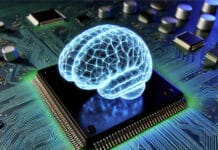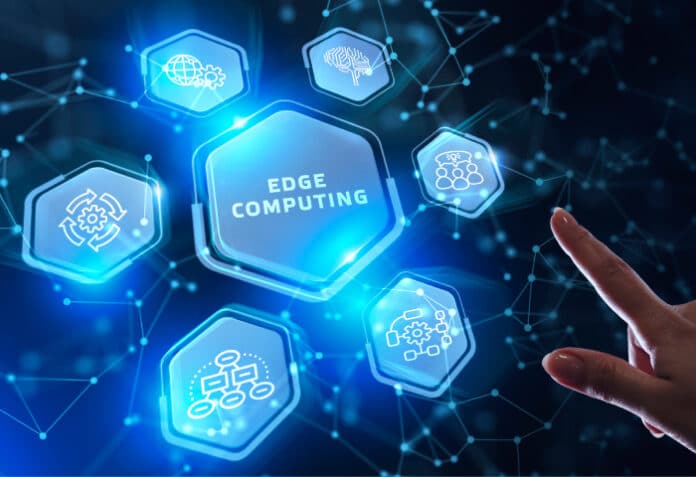As AI moves to the edge, decentralised model training and federated learning will reshape privacy and efficiency paradigms. The integration of peripheral AI with 5G technology will enhance the capabilities of devices on the edge.
The convergence of edge computing and artificial intelligence (AI) has resulted in the emergence of a paradigm shift referred to as edge AI. This novel methodology seeks to deliver the computational capabilities of AI directly to edge devices, including but not limited to smartphones, IoT devices, and other interconnected electronics. The integration of AI and edge computing facilitates instantaneous data processing, analysis, and decision-making at the network’s periphery, presenting a multitude of benefits in comparison to conventional cloud-centric AI frameworks.
Edge AI pertains to the implementation of models and algorithms for artificial intelligence that are executed directly on edge devices or local edge servers. By obviating the necessity to transmit data to a centralised cloud server for processing, edge AI effectively diminishes latency and optimises efficiency. By capitalising on the computational capabilities inherent in the devices, this methodology expedites response times and enhances the overall user experience.
Edge computing in AI
With the increasing need for real-time decision-making and low-latency applications, cutting-edge AI solutions are significantly contributing to the improvement of edge computing services. This article will examine the diverse applications of state-of-the-art AI technologies that aim to enhance and optimise the performance of edge computing services.
There is a growing emphasis among contemporary AI solutions on augmenting the functionalities of edge devices. By ensuring that edge devices can efficiently execute sophisticated algorithms, AI-driven optimisations enable data processing on the device. This feature not only diminishes latency but also empowers devices with limited resources to execute operations that were previously exclusive to more robust servers.
Edge AI reduces the temporal gap between data generation and processing through the direct execution of algorithms on edge devices. This is especially critical for industrial automation, augmented reality, and autonomous vehicle applications that require real-time responses to address key expectations.
Edge AI minimises the quantity of data that must be transmitted to the cloud by performing local data processing. This results in increased bandwidth utilisation efficiency and aids in mitigating network congestion, especially in settings with restricted connectivity.
By decreasing the quantity of data that must be transferred and stored in the cloud, edge AI can generate cost savings. This is particularly advantageous for enterprises that have implemented IoT devices on a large scale or are functioning in areas where data transfer expenses are high.
Advantages of edge AI
Edge AI, powered by artificial intelligence, facilitates the processing of data generated by sensors, IoT devices, and other sources in real time. Local identification of trends, anomalies, and patterns by machine learning algorithms obviates the necessity of transmitting vast quantities of unprocessed data to centralised servers.
Privacy and security enhanced by AI: By utilising cutting-edge AI solutions, security is improved via anomaly detection, threat identification, and predictive analysis. Adaptable to evolving cybersecurity threats, machine learning models offer a resilient defence mechanism. Furthermore, AI at the periphery guarantees enhanced privacy by locally processing sensitive data, thereby mitigating the potential hazards linked to the transmission of confidential information to centralised servers.
Dynamic resource allocation: In edge computing environments, algorithmic resource allocation is dynamic and powered by AI. By intelligently allocating computing resources in accordance with the workload, these systems effectively optimise performance and guarantee that critical duties are given precedence. The flexibility proves to be especially advantageous in situations where the periphery infrastructure may be confronted with sudden surges in processing demands or fluctuations in demand.
Cloud-to-edge collaboration: Contemporary artificial intelligence solutions enable smooth cooperation between edge devices and cloud services. Hybrid AI models allocate processing duties between the edge and the cloud in accordance with the computation complexity. This methodology enables the delegation of resource-intensive duties to the cloud, thereby guaranteeing that the periphery devices are capable of efficiently managing their portion of the workload. A scalable and well-balanced system is the outcome, which takes advantage of the respective merits of edge and cloud computation.
Predictive maintenance utilising AI: By analysing sensor data in real-time, machine learning models deployed at the edge can predict equipment failures, thereby reducing outage and maintenance expenses. This proactive approach to maintenance is especially beneficial in sectors like energy and manufacturing, where equipment dependability is of the utmost importance.
Edge autonomous devices: AI advancements are facilitating the increasing autonomy of edge devices. By utilising learned patterns and historical data, these devices can make localised decisions, thereby decreasing the reliance on continuous communication with centralised systems. The quality of autonomy is of the utmost importance in situations involving intermittent network connectivity or the need for prompt responses.
Edge AI and 5G solutions (decentralised model training)
In contrast to cloud servers, edge devices frequently possess constrained computational resources. The complexity and scale of AI models that can be deployed at the edge may be limited by this constraint. Implementing AI algorithms on edge devices can result in substantial energy consumption, which can have adverse effects on the battery life of mobile devices and increase the operational expenses of IoT devices.
The task of updating and maintaining artificial intelligence models on periphery devices can present significant difficulties. Frequently, cloud-based solutions offer enhanced simplicity in administration for model updates and version control.
The capabilities of peripheral devices can be enhanced through the integration of peripheral AI with 5G technology. The seamless environment created by 5G’s increased network capacity, faster data transfer rates, and decreased latency is ideal for edge AI applications. The convergence of edge AI and 5G technology yields significant effects in situations that demand exceedingly brief response times, including but not limited to connected vehicles, smart cities, and industrial automation.
Decentralised model training is a collaborative learning approach where the training process is distributed across multiple edge devices or nodes instead of relying on a centralised server. In traditional centralised training, all the raw data is sent to a central server, where the model is trained. However, in a decentralised model, training occurs locally on individual devices, and only model updates are shared.
The rise of edge computing and the advent of 5G networks have made decentralised model training more feasible and efficient. Edge devices, equipped with sufficient computational power, can now participate in training models collectively.
Key components of decentralised model training
Local training: Each edge device performs local model training using its own dataset. This dataset may contain unique patterns and characteristics specific to that device’s environment or user behaviour.
Model update sharing: After local training, only the model updates, rather than the raw data, are shared among the devices. This ensures data privacy and security, as sensitive information remains on the local device.
Aggregation and updating: The central server, or a coordinating entity, aggregates the model updates received from various devices. The global model is then updated based on the aggregated information, reflecting the collective knowledge learned from the decentralised network.
Federated learning
Decentralised model training is closely related to federated learning, a subset of this approach. In federated learning, the model is trained across decentralised edge devices, and the global model is iteratively improved without exchanging raw data. This iterative process allows for continuous learning and adaptation to local conditions.
To elaborate further, federated learning extends the notion of decentralised model training by permitting edge devices to educate a global model using the insights they gain from their local datasets. Following this, updates are made to the global model without requiring the transmission of raw data to a central server. This methodology not only guarantees confidentiality but also promotes ongoing education and adjustment to regional circumstances.
Advantages of decentralised model training
Privacy-preserving: One of the primary advantages of the decentralised model training is its privacy-preserving nature. Since raw data remains on local devices, there is no need to expose sensitive information to a central server, mitigating privacy concerns associated with centralised approaches.
Reduced latency: The localised training and model updating processes significantly reduce latency. This is crucial in applications where real-time decision-making is essential, such as autonomous vehicles, healthcare monitoring, and augmented reality.
Resource efficiency: Decentralised model training optimises resource usage by distributing the computational load across edge devices. This is particularly beneficial for devices with limited processing power, as it prevents overloading and ensures efficient utilisation of available resources.
Adaptability to dynamic environments: The decentralised nature of model training allows the system to adapt to dynamic and diverse environments. Localised learning captures nuances and changes specific to each device, leading to more robust and adaptive models.
Challenges and considerations in decentralised model training
Communication overhead: While decentralised model training reduces data transfer, there is still a need for communication between devices and the central server. Efficient communication protocols must be implemented to minimise overhead.
Heterogeneous data: Devices in a decentralised network may have heterogeneous data distributions. Ensuring that the global model captures representative information from all devices requires careful aggregation strategies.
Security concerns: While decentralised model training enhances privacy, it introduces new security challenges. Secure communication channels and robust encryption mechanisms are essential to protect against potential threats and attacks.
Table 1: How AI enhances edge computing services
| Feature | Description | AI-based approach |
| Low latency | Minimising the delay in data transmission for real-time applications | Implementing AI algorithms for edge processing, reducing round-trip times |
| Network slicing | Dividing a physical network into multiple virtual networks for different use cases | AI-driven dynamic network slicing for optimised resource allocation based on demand |
| Massive IoT connectivity | Connecting a vast number of IoT devices efficiently | AI-powered IoT device management for intelligent connectivity and resource allocation |
| Enhanced mobile broadband | Providing higher data rates for improved mobile connectivity | AI for optimising spectrum usage, predictive maintenance, and bandwidth allocation |
| Beamforming | Focusing radio signals in specific directions to enhance signal strength | AI algorithms for dynamic beamforming adjustments based on user locations and network conditions |
| Network security | Protecting against cyber threats and ensuring data integrity | AI-based anomaly detection, predictive analysis, and real-time threat identification |
| Resource allocation | Efficiently distributing network resources based on demand | Machine learning for dynamic resource allocation, optimising performance in real-time |
| Energy efficiency | Minimising energy consumption for sustainable network operation | AI-driven energy management, optimising power usage based on traffic patterns and demand |
| Quality of service (QoS) | Ensuring reliable and high-quality communication services | AI-based monitoring and adaptive adjustments for maintaining optimal QoS levels |
| Network management | Overseeing and optimising the overall network infrastructure | AI-driven autonomous network management for self-healing, configuration, and optimisation |
| Predictive maintenance | Anticipating and preventing network equipment failures | AI algorithms analysing historical data for predictive maintenance, reducing downtime |
| Edge computing integration | Incorporating edge computing for faster data processing at the network edge | AI for efficient task offloading, distributed processing, and edge-to-cloud collaboration |
| Dynamic network optimisation | Adapting the network in real-time to changing conditions and demands | AI-driven algorithms continuously optimising network parameters based on evolving scenarios |
Ensuring privacy in federated learning settings
Balancing privacy with utility in this decentralised setting requires careful navigation. Threats to privacy in federated learning are:
- Inference attacks: Even without raw data, patterns in aggregated updates or model parameters can leak information. Imagine a federated learning system for spam filtering. An attacker could infer which devices receive specific types of emails, revealing sensitive topics like health or finances.
- Model inversion: Trained models might hold the key to reconstructing individual data points. An attacker could reverse engineer a credit fraud detection model to uncover financial transactions of specific users, posing a significant privacy risk.
- Differential privacy trade-off: To protect individuals, noise is added to data. However, this can decrease model accuracy. Think of a personalised shopping recommendation system – too much noise might prevent it from learning your true preferences.
However, there are a few things that can be done to protect your data in the federated learning arena.
- Secure aggregation: Imagine devices contributing updates to a model without revealing individual details. Secure aggregation protocols like homomorphic encryption ensure only the combined update is visible, safeguarding individual contributions.
- Differential privacy: Imagine adding controlled noise to your emails before contributing them to a spam filter model. This ensures even if the model is compromised, it’s impossible to link any specific email back to you.
- Federated transfer learning: Instead of starting from scratch, pre-trained models on public datasets can be used as a base, reducing reliance on sensitive user data. This is like learning a new language by building upon your existing knowledge of a similar one.
- Federated learning with secure enclaves: Imagine training the model within a hardware-protected environment on your device, like a secure vault. This isolation further enhances data security, adding an extra layer of protection.
Ensuring privacy in federated learning requires more than just technical solutions. It also demands:
Transparency and fairness: Users need to understand how their data is used and have control over their participation. Algorithms should be designed to avoid bias and discrimination, ensuring everyone benefits from collective learning.
Security and robustness: Systems need robust security measures to prevent unauthorised access and manipulation. Regular security audits and penetration testing are crucial to safeguard data and maintain trust.
Regulations and compliance: Data privacy regulations, like GDPR and CCPA, need to be considered when implementing federated learning systems. Adapting to evolving regulations ensures compliance and user trust.
Real-world deployments and future scalability
The convergence of edge computing, artificial intelligence, and 5G technologies has created unprecedented opportunities for a wide array of applications, including industrial automation and smart residences. Although edge AI presents a myriad of benefits, its constraints must be acknowledged to fully exploit its capabilities; decentralised model training and federated learning must be implemented to achieve this.
Let’s explore some modern and exciting real-world examples of edge AI.
- Industrial predictive maintenance: Factories are deploying edge AI to analyse sensor data from machines in real-time, predicting potential failures, and preventing costly downtime. This optimises maintenance schedules and improves production efficiency.
- Retail smart shelves: Grocery stores are utilising edge AI to monitor product inventory levels on shelves, automatically triggering restocking when needed. This reduces stockouts and optimises store operations.
- Autonomous vehicles: Self-driving cars leverage edge AI for real-time object detection and decision-making, enabling them to navigate complex environments without relying solely on cloud processing.
- Smart security systems: Home security cameras employ edge AI to analyse video footage on-device, identifying potential threats, and sending alerts immediately, enhancing security and privacy.
- Wearable health devices: Smartwatches and fitness trackers use edge AI to analyse physiological data like heart rate and sleep patterns, offering personalised health insights to users in real-time.
In the future, edge AI can be scaled up for a range of services. A few are listed below.
Connected agriculture: Imagine vast networks of sensors in farms utilising edge AI to analyse soil conditions, optimise irrigation, and detect crop diseases in real-time, revolutionising sustainable agriculture.
Decentralised traffic management: Edge AI-powered traffic lights could adjust timings based on real-time traffic flow, optimise traffic flow and reduce congestion in smart cities.
Personalised edge assistants: Future edge AI assistants could learn and adapt to individual user preferences and context, offering highly personalised assistance in various aspects of daily life.
Enhanced robotics: Robots equipped with edge AI could make real-time decisions based on their environment, enabling them to perform complex tasks in dynamic situations with greater autonomy and agility.
Edge-based drug delivery: Edge AI-powered medical devices could analyse individual health data and deliver personalised medication dosages for enhanced healthcare management.
Edge AI, where machine learning models run directly on devices rather than relying on cloud processing, is rapidly transforming various industries. Its ability to deliver low-latency, offline, and privacy-preserving solutions is fuelling real-world deployments across diverse applications.










































































